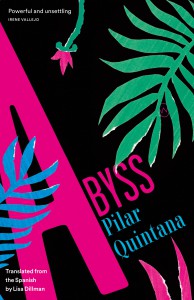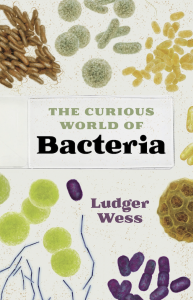This month, we are excited to present new works in translation that consider survival and coexistence in many forms. From the Hungarian, renowned author Magda Szabó delves into the embittering effects of poverty and hardship. From the Spanish, Pilar Quintana creates a riveting familial portrait of vulnerable parents and too-wise children. From the German, Dr. Ludger Wess leads us on a journey to discover the smallest lifeforms amongst us. Read on to find out more!

The Fawn by Magda Szabó, translated from the Hungarian by Len Rix, New York Review Books, 2023
Review by Meghan Racklin, Blog Editor
In The Fawn, the latest of Magda Szabó’s novels to be translated into English, it is 1954 in Budapest. For Eszter, the novel’s main character (it is difficult to call her a protagonist), it is 1954—but it is also the interwar years and the years of the war, and it is also, disastrously, almost the future. “The Future . . .’” she thinks, “[t]hat was something I had no desire to build. I had enough of the past about me already for the thought to do anything but horrify me.”
The novel is Eszter’s account of her life and her surroundings, told in a monologue directed at the man she loves, and the language is as beautiful as Eszter is bitter. In Len Rix’s translation, Eszter’s sentences are full of clauses; she’s in a rush, trying to get out everything she wishes she had already said. She recalls, of the evening when her childhood home was hit by a bomb, “Mother neither wept nor blanched; we slept the sleep of the contented in the main hall of a school, along with everyone else who had lost their homes; I felt like the nation’s favourite child, everyone seemed to want to look after us, and the whole city shared our grief.” As her outpouring continues, details pile up like debris.
Eszter grew up poor and uncared for in a small Hungarian town, in devastating proximity to both extreme wealth and intense love. Her mother’s wealthy family lurked just off stage, with a single aunt displaying thoughtless acts of generosity: she gave Eszter too-small castoff shoes that Eszter had to wear with toes cut off, and gold jewelry that Eszter sold to buy food. Her parents were incandescently in love, but, she reflects, “they were interested only in each other, they had no surplus feeling to share with anyone else, and certainly not with me.”
Her narration moves rapidly back and forth in time and place, from the feel of dirt under her feet and the children walking past her, to the cramped apartment and schoolmates of her younger years. Her childhood keeps pushing its way through her explanations of her current circumstances, delaying her arrival at whatever future it is she is moving towards. This persistence of the past in the present is a preoccupying concern in Szabó’s oeuvre; in Eszter, it manifests as a malignancy. “I know that we never forget anything,” Eszter says, “and that old Ince and Ambrus and his pigs and Angéla are still around somewhere and the memory of them grows and spreads down the years, like a cancer.” She has a perfect memory, which means she is always living in the past.
The man Eszter loves is married to a girl Eszter has known since childhood. This girl, Angéla, grew up in a nicer part of town; her father was a judge. “[T]here is always someone taking care of her,” Eszter explains, “someone holding her hand, someone stroking her arm or showing her the easiest way forward, and whenever I have seen her on her own, out shopping or with a book on her lap in the garden, she has never looked lonely or isolated because of her wonderful physical beauty.” But Angéla is kind, and Eszter knows it. “I never once saw Angéla eat a whole orange by herself; she always brought one for the mid-morning break, but as soon as she had peeled it she shared it around, segment by segment,” Eszter remembers, “I loved oranges, but I would rather have choked than accept a single segment of one from Angéla.” Angéla’s kindness is inextricably bound up in everything Eszter resents her for; “[R]age rose up in me,” she says, “because she always had the time and the means to do that sort of thing, she had no other business than to be the benefactor of mankind.” Generosity is something Eszter could never afford as a child, when her thoughts were always on finding enough money to feed herself and her sick father, and it is something she cannot even adapt to as an adult, although she has become a famous actress with her own lovely house on a hill.
The novel is shot through with the resentment borne of wanting things that are forever out of reach, which is to say that it is a novel filled with love triangles. Szabo fills the world with people who are not happy at home but cannot find happiness through leaving it. A woman has an affair and is murdered by her husband; a man’s mistress lives with him and his wife; and Eszter and her married lover are both resentful about her inability to give him a home—she can offer only a house.
Szabó is interested in the political at the scale of the domestic: the way larger forces warp relationships and the way relationships mirror the fractures of national history. Alongside the doomed love triangles of The Fawn are the triumvirates of past, present, future, and of Germany, Russia, and Hungary in the middle, rendered—by the heat of one war’s bombs and the chill of another’s—something less familiar and less comfortable than a homeland.
Eszter’s story is something like a confession, even if she is not sure exactly how much she regrets. Towards the end we find her “laughing at the monster I really am.” This is a story of how a monster is made and of how successive disorienting, alienating crises in twentieth-century Hungarian history—and most of all the distorting crisis of poverty, the crisis of class inequality and class resentment—has made its monsters.

Abyss by Pilar Quintana, translated from the Spanish by Lisa Dillman, World Editions, 2023
Review by Cecilia Weddell, Copy Editor
Abyss, Pilar Quintana’s second novel to appear in English, is—like its predecessor The Bitch, also translated by Lisa Dillman—concerned with the fraught relationships between caregivers and their dependents. Written from the perspective of eight-year-old Claudia, an impressionable only child living in Cali, Colombia, Abyss shows how much children understand of the adult concerns that surround them—and challenges the idea that any concern affecting a parent’s behavior can be classified as only “adult.”
In four parts, the novel follows a formative period in Claudia’s family life. In Part One, Claudia’s aunt, Amelia, fifty-one years old and never before married, returns from a trip to Europe and introduces the family to her brand-new, twenty-something husband Gonzalo. Claudia’s world-weary, twenty-eight-year-old mother (also named Claudia) is enlivened by Gonzalo’s presence, and soon, Claudia finds herself tagging along on after-school visits to the store where Gonzalo works, while, at home, a mysterious new caller only speaks when her mother picks up the phone. Predictably, the clandestine relationship between Gonzalo and Claudia’s mother doesn’t last long—by the end of Part One, they are found out and he disappears from the story.
While it is Gonzalo’s appearance and departure that spark the action of Abyss, the book is about much more than the reverberations of a parent’s likely infidelity. Part Two introduces Claudia’s mother’s “rhinitis,” the supposed reason she spends her days in the dark of her bedroom, her eyes red from crying and her back to the door. Rhinitis, to the reader, is a clear stand-in for depression: “One afternoon she told me that the last time she’d had rhinitis before this was when my grandmother died, and the time before, when my grandfather died.”
It is painful to read about “the worst days of her rhinitis” through her daughter’s eyes: “Claudia, not now, she’d say when I came in to say hello; Claudia, shut the door; Claudia, leave me alone.” The elder Claudia only offers genuine attention to stories about the early deaths of famous women: the drowning of Natalie Wood (“accidental, my ass,” she says), Grace Kelly’s death from driving off a winding road (“she was tired of all her obligations,” she insists), and Karen Carpenter’s heart failure from anorexia at thirty-two (“it’s when people kill themselves by starvation,” she explains). Quintana’s ability to make a reader feel both sorrow for this lonely, unsupported young woman, and frustration at the deep fears and anxieties she transmits to her wide-eyed daughter, is a remarkable balancing act. We feel for the elder Claudia; we also wish she would be a better caretaker to the younger Claudia.
In search of a balm, Claudia’s mother convinces her husband that the three of them should get away from the city for a time, to a house in the mountains where Part Three takes place. There, a cycle that is beginning to feel familiar starts again: Claudia’s mother is lively, talkative, and attentive for a time, before reverting to “spending all day in bed, with or without a magazine, staring at the ceiling or walls.” Like the mountain’s thick fog, her “rhinitis” casts a darkness over the vacation home. While her father is away all day at work, Claudia watches her mother carefully, worrying about her whisky intake and the steep cliffs surrounding the house:
I thought about all the dead women. Staring out over the precipice was looking into their eyes. […] I looked at my mother, leaning over the abyss like me.
“We better go back.”
Beyond the marital strife and beyond the mother-daughter relationship, this book is about what is passed down through families—names, worries, fascinations, stories, yearnings—and how each generation accepts, resists, and is haunted by these inheritances. All of Claudia’s grandparents died before she was born, but she senses their presence in the plant-filled apartment she lives in with her parents, so green she calls it “the jungle” (“I always thought of the plants as my mother’s dead. Her dead, reborn”), and in her father’s quiet (“like people drowned in a calm sea, my father’s dead, I began to think, resided in his silences”). Claudia’s ability to see and, paradoxically, hear her parents’ grief is a reminder that disguises hardly ever work on those who know us best.
In this context, Quintana’s use of a child narrator is apt; in its execution, it is masterful. Claudia’s observations are believable for her age, impressive for their perceptivity, and fair to her intelligence. When her mother takes her along to see Gonzalo, she notices “under the changing-room door, two pairs of shoes, Gonzalo’s brown loafers, and my mother’s red heels, braided together”—but lets on little else as to her understanding of these trysts. It is only when her father furtively asks her about the after-school visits that it becomes clear Claudia knows the danger they pose to her home life: “I looked at my father, thinking, why are you doing this to me?” Later in the novel, a scene Claudia does not narrate in the moment—we only learn about it through her parents’ questions over dinner—reveals the seriousness of Claudia’s struggles through its omission; a child would have trouble putting these feelings into words.
All that there is to praise about this novel—the complexity of emotion it evokes in a reader, the success of its child narrator, the undercurrent of dread in its descriptions—must be credited as much to Dillman as to Quintana. It is a particular treat to see a work gain from its translation, which Abyss does when the word tocaya—one who has the same name as another—is translated to “namesake,” with all the associations of inheritance that it carries in English. When both Claudias refer to the other by the nickname “namesake” at different points in the novel, their shifting sense of responsibility for each other weighs on the word. A deeply humane exploration of relationality, Abyss is unafraid to look into its own namesake for the truth.

The Curious World of Bacteria by Ludger Wess, translated from the German by Falk Nordmann, Greystone Books, 2023
Review by Charlie Ng, Editor-at-Large for Hong Kong
In our day to day life, we usually come across two kinds of bacteria: the good—commonly known as probiotics that help to maintain gut health, and the bad—pathogens that haunted our ancestors like evil hexes until their truth was revealed by scientific discovery. Although bacteria coexist with human beings, these invisible life forms mostly elude our attention; even when they can be seen with the aid of a microscope, the strange, seemingly simple organisms can hardly be associated with the lifeforms we are familiar with.
In the interest of help us better understand these essential creatures, The Curious World of Bacteria, written by German molecular biologist Ludger Wess, is an accessible popular science book dedicated to these wondrous microbes. Within its pages, Wess sketches fifty fascinating portraits of bacteria—a carefully chosen, representative range that gives the reader a glimpse into their world, along with an informative introduction. Compared to the estimated trillion of existing bacteria species—which is said to be “roughly five times the number of stars in our galaxy”—fifty is insignificant. However, Wess’s selection is well-curated to showcase the robustness of their life, and the pivotal roles of bacteria in both human lives and the ecosystem of our planet.
Bacteria—or more precisely, the prokaryotes, to which bacteria belong—were the first forms of life to emerge on Earth. Microfossil discoveries showed that 4.3 billion years ago, life appeared in “the areas around hot springs on the ocean’s floor”—a hundred million years before the formation of the first oceans. Throughout the geological history of Earth, there were times when environmental conditions were extreme, but bacteria were able to survive thanks to their unusual metabolic characteristics. Today, although Earth’s climate is quite accommodative to a vast range of organisms, there are still arduous habitats where only bacteria can readily live. In one section of The Curious World of Bacteria, Wess discusses fourteen species of “extremists,” each of which is specialised to live under inhospitable conditions—unbounded by temperature, acidity, air pressure, aridity, or the lack of energy sources in the surroundings. Each species has developed unique characteristics or strategies to withstand harsh environments. For example, the cold-resistant species Colwellia psychrerythraea is active at temperatures as low as -20°C, and its metabolic activities can still be detected even at -196°C in liquid nitrogen; its capacity to live is due to it being covered with “cold-adapted (cryoprotective) polymers,” as well as its “enzymes operating outside the cell.”
Another species, Magnetospirillum magnetotacticum, has structures called “magnetosomes” in its cell, which allows it to collect iron ions from the environment. Those then form into magnetite crystals for the bacterium to follow the Earth’s magnetic field lines, allowing it to sink to the bottoms of waters, where the species can thrive. There is also a variety of zombie bacterium, Chromulinavorax destructans, that floats around freshwater without any metabolic activity until it is swallowed by the golden alga Spumella elongata, which activates it to eat up the algae. Another unique species, Cupriavidus metallidurans, loves copper, and is adaptable in environments with a high concentration of heavy metals; it was first discovered in a zinc smelting plant’s wastewater. This bacterium offsets the toxic effects of heavy metals through a system of proteins, which can transport metal ions in and out of its cell, to maintain the appropriate amount of ions for its own use.
The ingenious properties of bacteria are not only useful for their own survival. In discovering the incredible capacities of bacteria, biotechnological scientists can make use of their tools to help human beings accomplish a vast variety of undertakings, from making gold nuggets to treating radioactive waste. For example, Deinococcus radiodurans is a remarkable species that can survive high radiation levels due to its very strong cell wall, and the ability to efficiently repair its DNA with enzymes. It is even speculated that this species gained its ability from withstanding the cosmic radiation on Mars. Regardless of its origins, its discovery is significant in finding solutions to handle nuclear waste.
Additionally, bacteria also bring potential solutions to the problem of plastic pollution. Ideonella sakaiensis can break down PET, the plastic material commonly used for making bottles and food packaging. The bacteria can secrete an enzyme called PETase, which breaks down PET into MHET, an organic compound that can be further decomposed by another enzyme, MHETase, into chemicals for the bacteria’s energy production. With the help of genetic engineering, the process can be expedited for large-scale recycling of PET. This process may take place even underwater, with the bacteria digesting microplastics.
As a work of scientific non-fiction, The Curious World of Bacteria is more informative than creative, but the little narratives, interwoven with factual knowledge, make the work an enjoyable read. Wess tells personal stories of his childhood fascination with bacteria and how he came to be devoted to their study; gives a brief account of the beginning of planetary life and the process of evolution; and frequently uncovers the history of discoveries and innovations in microbiology and microbiotechnology. Writing about the world of bacteria is inevitably an act of narrating the human quest of venturing into and charting this other territory of our invisible, strangely intimate neighbours—a journey that requires great diligence but is also often aided by seemingly fated serendipity. Wess’s prose is lucid, explanatory, and amiable, rendered fluently by Falk Nordmann’s translation. Ending on the seemingly limitless knowledge of bacteria yet to be explored, Wess’s attitude is enthusiastic—not only because an increased understanding of these curious organisms enlightens us to how they affect us and our ecosystems, but because these tiny creatures also pave a path into the greater mystery of life, leaving us bewildered and marveling at the wonders and resilience of nature’s creation.
*****
Read more on the Asymptote blog:
- What’s New in Translation: January 2023
- What’s New in Translation: December 2022
- What’s New in Translation: November 2022

